#boat towing service
Text
Tales From Dispatch, Pt. 22
(about a call to a boat having trouble on a lake)
ME: Officer Friendly, the caller on your call called back to let us know they can't see if anyone is injured, but the boat is definitely capsizing.
OFFICER FRIENDLY: The boat is what?
ME: ...Capsizing.
FRIENDLY: ...10-4?
OFFICER OTHERGUY: They mean it's sinking.
ME: *realizing that Friendly did not know until now what the word "capsizing" meant* Affirmative.
#humor#tales from dispatch#yeah#bro definitely did not know what 'capsizing' meant#i 100% was laughing at him#super hard#the boat was fine tho#turns out their battery was just dead and they needed a tow back to shore#and weren't actually capsized at all#emergency services#actual 911
3 notes
·
View notes
Text
4 Inspiring Commercial Wallcoverings For Your Office

Experts in workspace interior design are sure that your workplace should always be considered a place of employment first. Additionally, workplace interior design needs to promote cooperation, increased productivity, and creative thinking. If you've been considering a new office interior design in Dubai, the suggestions below can help you create a lively environment at work.
Accent walls
A quick way, and an affordable one too, to liven up creative office design is to have an accent wall. It could be just a bold color on the chosen wall, placing a bright mural, or an oversized logo. These would make a statement. Choosing the space for the accent wall would be best with advice from workspace designing experts. The wall has to be visible to many employees. The offices sporting the best interior solutions usually choose the hallway, lobby, or conference room to have the accent wall.
READ MORE
#yacht maintenance#boat maintenance#super yacht#yacht services#mega yacht#boat services#boat maintenace#yacht repair#in Dubai#yacht refit#yacht management#boat refit#Yacht price/ cost#yacht towing#boat towing#Dubai UAE#yacht interior refit#yacht refit cost#yacht refit companies#superyacht refit#megayacht refit services#yacht repair services#yacht rebuild services#superyacht repair services#megayacht repair services
0 notes
Text
How to Choose the Right Window Glass for Your Yacht Including the Thickness

To preserve your boat or yacht in Dubai, United Arab Emirates, seaworthy for a longer length of time, it is crucial to take adequate care of it. Selecting the proper material for the windows is one of the most important components of yacht renovation or boat maintenance. Typically, the windows of maritime vehicles such as boats and yachts are created out of specialist materials rather than glass. Furthermore, they are built to survive exceptionally difficult operational circumstances out at sea.
The most commonly used marine window materials are:
Acrylic Glass
Acrylic glass is a sort of plastic that is not only incredibly resilient but also adaptable. Acrylic resists shattering, making it incredibly hard to break. It is also waterproof and weatherproof. Acrylic is also salt-water resistant, making it the ideal material for yacht windows. It provides superb visibility because it is also transparent glass. To gain more insight into this, speak with a supplier of megayacht refurbishment services in Dubai.
READ MORE
#yacht fiber glass maintenance#boat fiber glass maintenance#yacht fiber glass repair#boat fiber glass repair#yacht fiber glass services#boat fiber glass services#yacht keels and rudders repair#boat keels and rudders#yacht gelcoat services#boat gelcoat#yacht maintenance#boat maintenance#yacht services#boat services#yacht repair#yacht refit#boat refit#yacht towing#boat towing
0 notes
Photo

Boat towing service in Melbourne Casey Towing Transport 39 Majestic Blvd Cranbourne VIC 3977 0435 555 400 https://ift.tt/ULr085o . #caseytowingtransport #towingservice #cartowingmelbourne #towtruckservice #melbourne #VIC https://ift.tt/wcXVWKD
#Boat towing service in Melbourne
Casey Towing Transport
39 Majestic Blvd
Cranbourne VIC 3977
0435 5
1 note
·
View note
Text
vacation
I'm in Maine with my dude. Our anniversary is around the 4th of July so we kinda try to do stuff around then. This year is 22 years, which marks the point at which it's been more than half of each of our lives. So that's keen. Not to be mushy.
I just saw a thing about celebrating Pickett's Charge Day and it amused me a lot. As an impressionable child I read Michael Shaara's The Killer Angels repeatedly, which is an account of the battle of Gettysburg with alternating points of view from participants on both sides-- it was adapted into a movie but I didn't see that so IDK if it captured any of what I found so poignant in the narrative. (Does the song Kathleen Mavourneen play a big role in the movie? bc it does in the book.) But because of this I knew that it was the 20th Maine Reg't led by Col. Joshua Chamberlain that held the left flank against repeated assaults on that day, so it seems fitting. I looked it up before I posted this, but I did actually know that.
No, I've never been to the battlefield at Gettysburg either, I'm a poor secondhand student of the civil war. My mom wrote a book about it but it's unpublished, she just put it up on the town website. LMK if you want to read it (I'm not linking directly to it because it's on the town website so it's kind of uh doxxy, LOL); it's an extremely dry work, simply recounting the results of her research into the service record, origins, and ultimate fate of every single person she could track down who either served in the regiment our town sent to the war, OR who served in the war and later settled in our town. It was years of research by her including many trips to battlefields. This is my background, is all I'm saying, and the reason why I know the names of like a bunch of the colonels at Gettysburg without checking.
Anyhow. We're not up here for civil war purposes, we're here to sit in a house on a lake and listen to some loons. We went last night and got on a schooner and schooned around Penobscot Bay, which was fantastic; saw the sunset, but not the moonrise, as it was cloudy. It's been mostly rainy here but it stopped raining long enough for that and that's all I care about. If it rains tonight, so much the better, as it'll keep the noise down. Na ha I'm the Grinch of the Fourth of July.
so anyway a couple of photos and some meandery stories behind the cut:

I'm putting the descriptions/captions in the alt, idk how well that works. Ah you can see the lighthouse here-- Camden, ME has a slightly dangerous harbor entry , with two nice wide channels that allow easy entry but a large submerged rock ledge in the middle that at high tide is completely invisible. Every year, our skipper said, some boat forgets about this and runs violently aground. This year's sacrifice was a 50-foot powerboat, and he heard the mayday call as he was on his morning commute. Some lobstermen were in range and managed to haul the boat off the rocks and tow it in to port, but it sank in the launch area-- still, they could easily raise it from there. The passengers were all unharmed, following behind in a dinghy very abashed. A couple weeks later on one of his several-times-daily tours our captain found all the cushions from the wrecked powerboat washed ashore in a nearby cove, and was wondering at the etiquette-- should he collect and return them? He did not reveal whether he had, as conversation moved on.
He was a college kid, raised locally, home for the summers, but in his senior year as a computer engineer up at the U of Maine in one of the campuses about an hour away.
Since it was not very windy we had to use the motor a bit, but we did sail for a goodly while, and in the very light breeze he said "So I'm going to do a controlled jibe here, because the wind is super chill, and if you know a lot about sailing you'll know why I've been taught not to do this move but this is the ideal condition for it. So everybody duck, I'm holding it but the boom is going to move."
A schooner has two masts, so that meant both booms moved. And the mate controlled the forward one admirably, and he the aft, and we were all fine. But as we were coming into the harbor and taking the sails down, the forward boom swung again a little unexpectedly, and the passengers sitting below it had to duck. The mate worriedly asked if everyone was okay, and one woman said "Oh, no, I had a past life regression where I learned I was killed by a sail boom, so I'm really good at ducking!" to which the mate cheerfully, slightly awkwardly, replied "Oh that's great! that! uh! I mean not that you died! But that you didn't this time!" which was extremely gracious of her, especially given that she was about seventeen years old. (She had just been explaining to us that her doctor made her wear glasses full time now because she had gotten her driver's license and he didn't think she should drive without glasses.)
ANYWAY the lighthouse at Camden has been automated since the 1980s, like all US lighthouses, BUT has still had a lighthouse keeper-- a local woman lived there 50 years and raised a family there and only recently at 90 retired as the keeper, and now the assistant harbormaster lives out there. Nobody really needs to be in that lighthouse but it's a point of local pride to have a manned lighthouse.
There are also bell buoys, which I hadn't really noticed as a thing before-- but it's just a buoy with a large bell on it, and the waves' rocking tolls the bell constantly, and it's meant to warn of a hazard. There are several in Camden harbor, because there are a number of very tall rocks that stick up out of the otherwise mostly 180-200ft depth, and some of those rocks are submerged at high tide so you would never see them coming and your onboard depth sensor thing wouldn't catch them in time. (Those rocks, our skipper said, are called The Graves, because of the number of wrecks on them, but they're so steep you can almost touch them from the side of a passing boat; they're used as turning points in some of the tall ship racing that happens locally, and he was aboard one once that turned so tight around one of those rocks and he said he was so terrified the whole time and would never himself sail that close to one.)
It was so calm while we were out there-- Lake Erie is choppier-- but it was sunset, which is when the wind changes direction usually, and the weather here has been heavy rain for days and it was a break in the weather. Anyway that was the Atlantic Ocean, though we weren't really out in it, it was all Penebscot Bay.
Apparently the Olad's original name when commissioned was The Whistle Binkie, which is terrible and hilarious.
OK next slide, good thing I'm only doing two
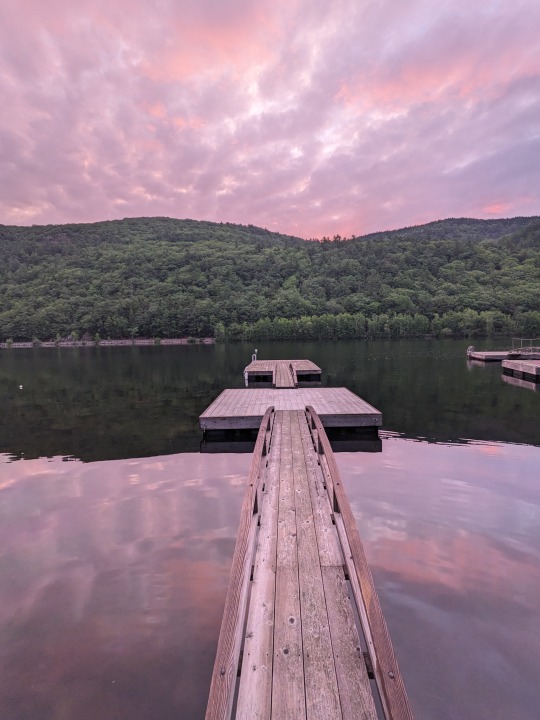
Good morning, I woke at 5 and noticed the sky was pink and knew it would be fleeting, so I threw my bathrobe on and went out even though I really needed to pee, so I suffered for this art-- I got out a little ways on the dock and listened to a loon calling and took several photos, and then went inside and when I came back out the light had gone, so I'm glad I ran out when I did. Those bridges are narrow though, and I'm not the steadiest when I first wake up, so I was not going all the way out to that last dock. The view is great from that last dock but the great view is to the north, and the pink clouds were to the west, so for this photo, this was the better view anyway.
This is Megunticook Lake.
Today we have no plans; the restaurants downtown were nuts last night, we walked into one place at 4:45 and were told we could be seated around 6:25, so we walked back out and went instead to the Sea Dog brewery, which I had heard of-- I've had their beer somewhere-- but we're thinking tonight will be nuts, so we're going to stay home and eat the stuff we brought for today's lunch instead, and we're going to venture out for lunch today in hopes that it will be less insane.
We'd asked the skipper of the Olad what the 4th of July was going to be like, did he have the day off etc, and he laughed and said no, he works on that day, but it is kiiiind of the worst, because everyone with a boat or access to a boat has to take it out on the 4th of July, and they're all drunk, so he spends most of the day trying to avoid drunk boaters and trying to make sure nobody falls off his boat. (When we'd boarded he'd given us the rules before we pulled out of the berth, and the only actual rule was stay on the boat, and I don't like to think about how emphatic he had to be about that.) I think I mentioned, he was like twenty, and when someone asked him how long he'd been doing this he blithely said "oh this is my first day!" but then admitted it was actually his first season as skipper, but he'd been crewing these kinds of boats for about five years now. Uncommonly among tourist attractions, his job had gotten more busy during the pandemic, because honestly it's an extremely low-risk activity, you could not be any less enclosed, though they had to abide by the same regulations re: mask wearing as airplanes and large commercial ferries, so it was a bit silly-- but absolutely lowest risk of all given that they're wind-operated.
So we know Camden town is going to be insane all day tomorrow, and there's a fireworks display they launch off a boat in the harbor, and we are not going to attempt to go see it! We will hear it from here, and that is fine. We brought our own sparklers, should we be so inclined.
30 notes
·
View notes
Note
HELLO my tumblr twin, it’s your turn to share something spooky from where you’re from!
Tales From the Perth Regions
Okay I dragged my Dad into helping me answer this ask because that man knows everything there is to know about The Happenings of this area.
These are my favourites.
The Satanists of Kings Park
To those unaware, Kings Park is one of the largest gardens within a city in the world. That place is fucking massive, and contains a lot of thick bush. One of the landmark buildings in the park is the DNA tower, named after its shape.

Also, unrelated but the vantage point from the top of the tower is pretty neat.
Popular local legend goes that from the mid to late 70s a group of Satanists and Devil-worshippers would gather on full moons at midnight to have meetings and dances on the tower, terrorising any outsiders that dared to get close. Over the years a few homeless people who slept in the park have gone missing or found dead leading many to believe they were sacrificed in a ritual.
My Dad never personally got chased out my a mob of Satanists, but many of his mates claim to have seen their dances.
Personally, I find this one rather rude. Im a bit miffed I didnt get an invite to these meetings. Mayhaps the kings park satanists are a tradition in need of revival.
The Wreck of the SS Alkimos
Boy oh boy this is a long one. Buckle up.
No idea about how much of this is factual, but as requested this is as much of the story as I can recount as it is told through the broken game of telephone.
Upon its construction, the Alkimos experienced its first tragedy. The story goes that during construction, eleven workers were trapped between layers of metal. They all suffocated to death. Some say their bodies werent found for days, while others say their corpses were never removed.
The ship saw active service in WW2 when its second tragedy occured. Some radio operator was killed in a muder-suicide on board which was covered up as an enemy attack. Apparently the radio opperator was the first Toronto woman to die in active duty during WW2. Her name was... Maud? I think? Her ghost is said to haunt the Alkimos. Now, this is a detail thats neither here nor there, but Dad says many radio broadcasts were made back in the 50s on the Alkimos wreck trying to document it for the public, but almost all of them failed or experienced a malfunction during transmission. Bit of an odd coincidence, no?
Now on to the weird shit.
On a trip to W.A., the Alkimos wrecked on Beagle Island. It was salvaged and towwed to the Freo ports for repair. It was then towwed out by an ocean-going tug boat to Kong Kong when the tow cable broke, and sent Alkimos right back to wreck on the coast of Freo. They flooded the hull to keep her stationary, and posted an onboard watchman. Dad says this watchman was driven off the job, claiming the ship was haunted. The Alkimos was repaired one again, and was leaving for the Philippines but the tug assisting got recalled due to a storm and Alkimos took anchor. The anchor broke, and sent the Alkimos back to run aground at Yanchep, only an hour-ish from Freo port. They gave up trying to restore her after that, and there she still remains to this day.

And now the bat-shit stuff.
Multiple scrapping companies attempted to scrap parts of the Alkimos over the years after everyone gave up trying to fix her. One company reported that every time they tried, a fire would break out on board. Every time they came back the fire would somehow restart and drive them away. A few of these companies went bankrupt soon after. Thus, the legend that removing any part of the Alkimos was an omen of terrible luck.
It is said that many ghosts haunt the wreck. The most famous being Henry, the ghost of an elder man in gumboots and an oil skin. Apparently he's nice enough. My Dad's mate, Jack Sue, wrote a book about the ship ( The Ghost of the Alkimos) and during his stay on board the ship for research he bunked there over night. He said that he woke one night to pained moans from the nearby bunk, and upon turning on his torch, the sheets of the bed went sailing across the room. He said that you could hear voices aboard and the smell of cooking despite it being abandoned. He took a spice rack off the ship, and immediately was hospitalised with some sort of lung infection. However, his lungs were already fucked by the war, so its not like it was very out of the blue. He died fully convinced the ship was haunted, and he was not the sort to shake easy.
Around the late 1960s, champion swimmer Herbert 'Shark Bait' Voigt attempted an unassisted swim from Cottesloe Beach to Rotto, an island off the coast of W.A. (from which the main access point is via the Freo port) Anyway, he was never seen again. A few weeks later, about an hour north of his departure point, his skull was found floating above the wreck of the Alkimos my an escaped prisoner. Some versions of the story say is was found over the wreck, some say about 200m off the wreck, and others say it was found in the flooded engine room. Nobody knows for sure. Regardless, the cause of death was never determined.

The Alkimos has been blamed for so many misfortunes, deaths, mishaps and the like in the area that its impossible to tell you all of them. My Dad even blames a missing half a tank of petrol on the Alkimos from when he rode there.
If you want to learn more, i bet that book would be a great place to start.
Either way, seems like a great scuba place to me! I will for sure be diving what remains of the ship the second I get the chance. And I will be taking what ever I can get my mits on from the wreck.

Sadly, almost all the ship is underwater these days, but nothing a snorkle cant fix! If I go missing after announcing a trip there, you will know why.
#rewriting this whole ass essay bc tumblr didnt save my draft#batshit aus things#western australia#you may be a trains autistic but i am a shipwreck autistic. specifically haunted shipwrecks.#i froth at the mouth over a good ship wreck#i wanna go there so bad#i dont usually believe in ghosts but the Alkimos is WEIRD#kings park satanists plz invite me#i dabble in satanism and i wanna be a local legend#asks#moots my beloved#Lost is my tumblr twin#Oh! and also the perth hills people believe there are panthers and tigers and shit in the local bush
11 notes
·
View notes
Text
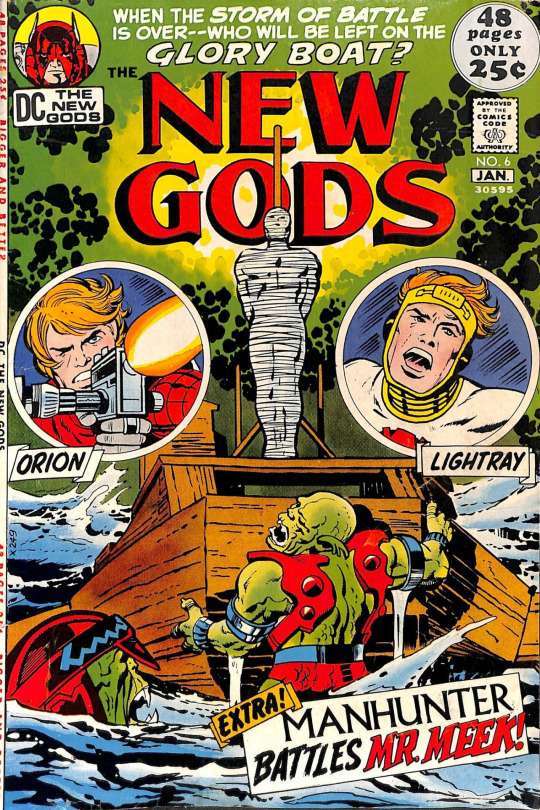
December 1971-January 1972. If you've read any number of comic books at all, you probably have an idea what Jack Kirby stories dialogued by Stan Lee sound like. Here's a fine sample of Kirby's own writing and dialogue, unmediated by Stan Lee, in one of the best stories in perhaps the greatest series Kirby did at his creative peak: "The Glory Boat!"
The premise of "The Glory Boat!" is relatively straightforward: A squad of ocean-going villains from Apokolips called the Deep Six is wreaking havoc throughout the Atlantic Ocean, so Orion, champion of New Genesis, sets out to stop them.
Into his path comes a life raft containing three ordinary people, the survivors of a yacht wrecked by the villains the night before. Taking the raft in tow with a magnetic force beam, Orion follows a signal from his Mother Box (the sentient living computers of New Genesis and Apokolips) that leads him to "an ugly, misshapen craft made of aged wood--with a bound, man-like figure for a mast," as seen on the cover above. Having no time to take the shipwreck survivors to shore, Orion brings the three to this curious vessel, where he discovers that the figure on the mast is his friend Lightray, previously captured and bound by the Deep Six. Once Lightray is free, introductions are made:
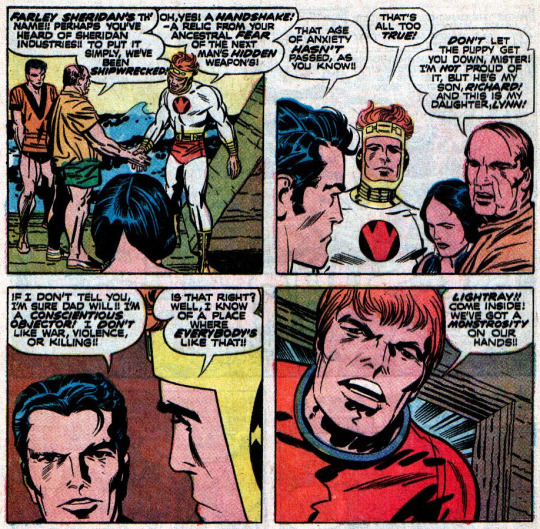
This issue was published during the Vietnam War, so Richard Sheridan's conscientious objector status means that he's not merely a pacifist, but has been able to convince his draft board that he is so philosophically opposed to war that they have granted him alternative service. Achieving this, especially if you weren't a clergy member of some kind, was not easy, but Richard's father, Farley Sheridan, is obviously unimpressed. Lightray, however, finds it perfectly reasonable — although note the ironic cut to Orion, who is definitely not "like that!!" (Although he's a defender of New Genesis, Orion is a curiously feral individual, the reasons for which Kirby had not yet revealed at this point in the series. Orion himself is something of a monstrosity: the son of Darkseid, raised by his greatest enemy.) On the other hand, while Lightray is at least superficially more sympathetic than Orion is, note that he's really quite condescending, a consistent feature of his interactions with Earth people.
Orion and Lightray investigate the cabin of the strange craft, and discover that it houses a ghastly mutated thing, which Orion calls a "Sender" and which is controlling the sea monster the Deep Six are using to destroy ships. Orion is prepared to kill the Sender, but Lightray insists, "It shouldn't be destroyed!! It should be changed!!"
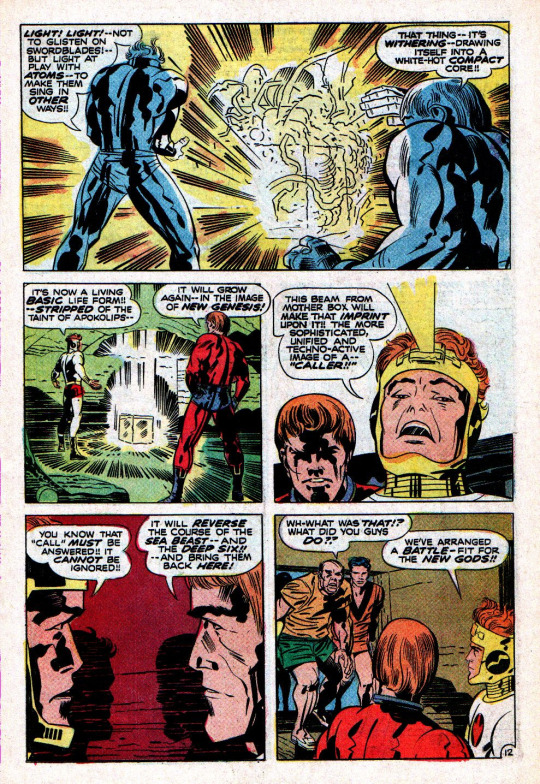
Lightray's Mother Box is in the front of his headpiece. In the original Fourth World books, Kirby modeled the Mother Box on tefillin, which are small leather boxes containing scrolls with Torah verses. Tefillin are worn strapped to the head and the arm; the New Gods generally wear their Mother Boxes on one or the other. (Orion, the contrarian, usually carries his on the front of his Astro-Harness, the glider he uses to access the Astro-Force.) Note that while Orion obviously understands what Lightray is doing, this is all Lightray's show; even Orion has to cover his eyes at the forces Lightray is unleashing.
Mother Box reduces the Sender to a cube-like "basic life form," but this is only the beginning of its transformation. Over the next few pages, it becomes "techno-active," growing and changing into something quite different, as we'll see.
Meanwhile, the Sheridans have what's clearly just the latest in a long series of arguments between Farley and Richard, with poor Lynn (whose nerves seem understandably shot) caught in the middle. The gist is that Farley, who, like Kirby, is a WW2 veteran, thinks that Richard's pacifism makes him a coward, declaring, "Well, at least I fought! When my outfit hit the beach at Normandy, I walked into that rain of bullets with the rest of them!!"
This argument is interrupted by the arrival of Jaffar, one of the Deep Six. Confronted by this monstrous creature, Farley freezes in terror, but Richard chooses to fight for his father and sister:
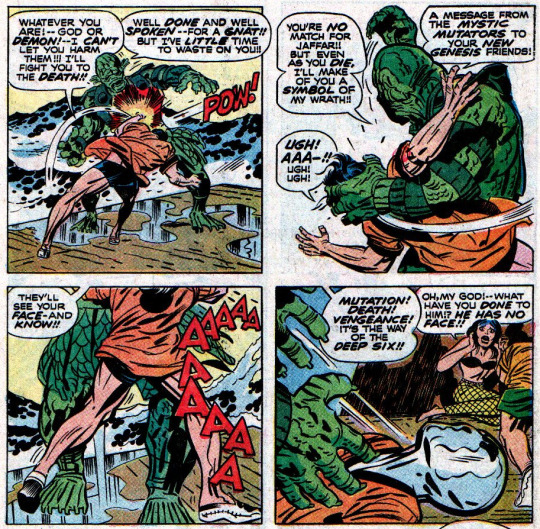
Despite Lightray's earlier contention that transformation is an alternative to destruction, for Richard Sheridan, it means not only death, but also the loss of his identity, in a way that obviously parallels the way Lightray previously turned the Sender into a simple "life cube." Another important point here is Jaffar's acknowledgement of Richard's futile courage; grudging respect for an opponent engaged in a struggle they can't possibly win is a device that recurs throughout the Fourth World saga.
Orion responds to this atrocity by killing Jaffar (the second of the Deep Six he's killed; he killed another in the previous issue), but seeing his son reduced to a literal faceless victim is too much for Farley Sheridan. He's gotten what he said he wanted — his son has leapt into harm's way when called — in a uniquely awful way, and his mind snaps:
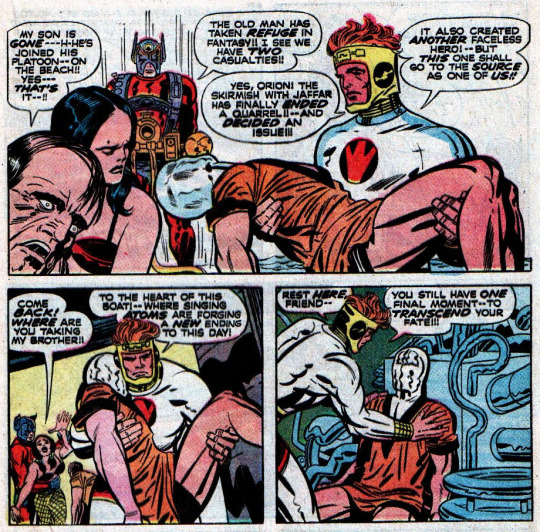
Richard Sheridan is dead, but his journey isn't yet over. As his father imagines himself back on the beach on D-Day, Lightray carries Richard's body to the heart of the "techno-active" transformation still taking place within the weird craft. Orion, meanwhile, straps Lynn into his harness to carry her away from the imminent confrontation with the rest of the Deep Six. Farley Sheridan remains:
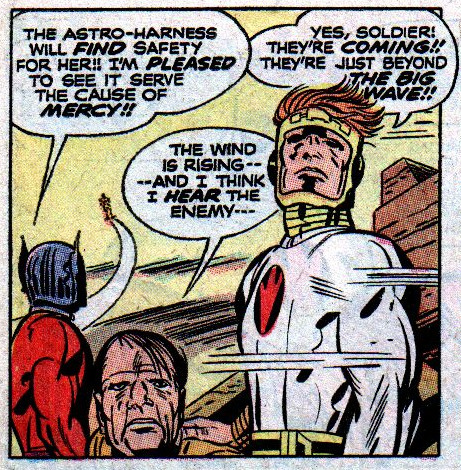
A lot of Kirby's dialogue in this series has the pace and cadence of a stage play. Note how Farley and Lightray narrate parts of the action the reader can't feel or hear. Unlike a stage play, though, this isn't a way of talking around battle scenes or vistas that can't be shown — there will be real fireworks, and imminently. Rather, Kirby uses this technique to add a sense of anticipation and gravity to the situation.
Orion grapples with the rest of the Deep Six on the deck of the wooden boat, which soon catches fire. However, there's still a bigger threat on the horizon: the villains' mutant leviathan, which is fast approaching, drawn by the signal of the transformed "Caller." To Orion's annoyance, Lightray has occupied himself making some seemingly dubious tactical decisions. A central aspect of Lightray and Orion's friendship in the Kirby stories is that Lightray is not really a warrior at heart, often seeing the war as an elaborate game. This frustrates Orion, sometimes for good reason, but it also sometimes gives Lightray insights Orion lacks:
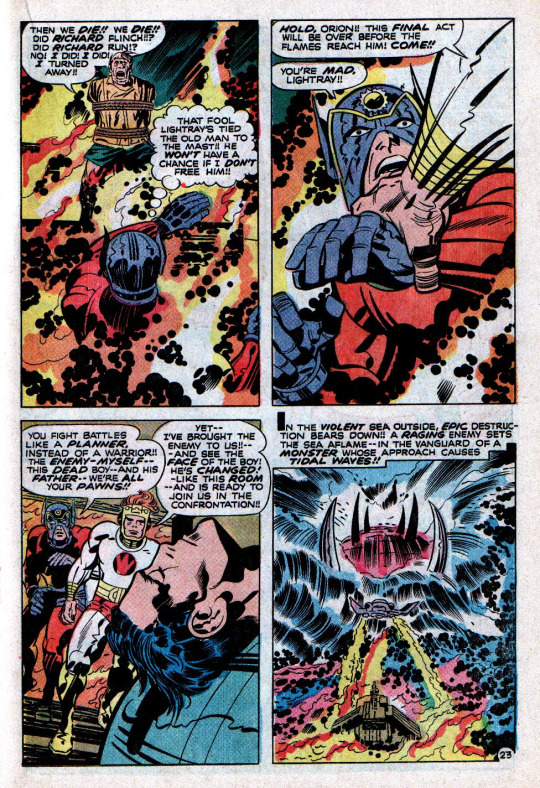
Richard Sheridan is still dead, but the techno-active process has now restored the face that he lost when he chose to abandon pacifism to fight for the lives of his father and sister. Meanwhile, the big wave Lightray spoke of before is finally breaking, revealing the leviathan, the ultimate product of the Deep Six's more horrific transformations. However, Lightray has prepared an answer for that as well. This is what finally emerges from the transformed Sender, the final form of the "Glory Boat" of the title:
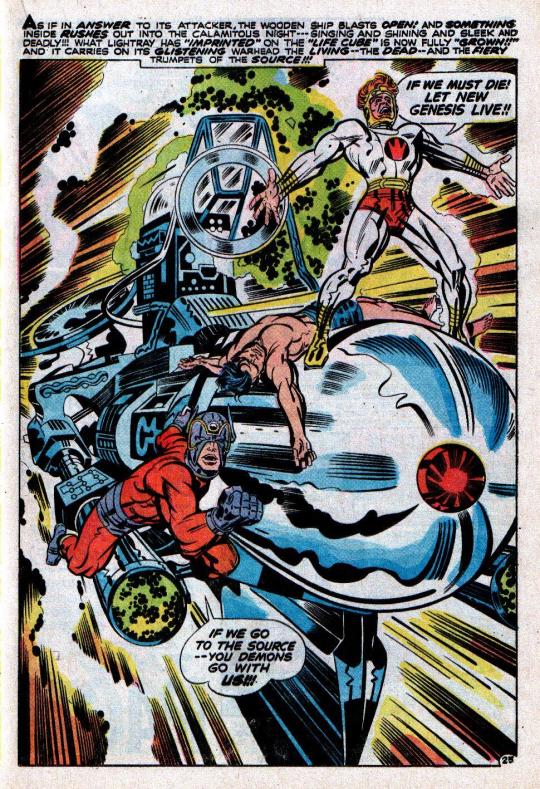
This strange torpedo collides head-on with the leviathan in an apocalyptic cataclysm: "Thunderous notes!— White-hot, elemental and all-consuming!! A Wagnerian offering to the Source!!" Lightray, who can fly at incredible speeds, carries himself and Orion away as the explosion consumes the leviathan, the Deep Six, and the mortal remains of Richard Sheridan. As for his father:
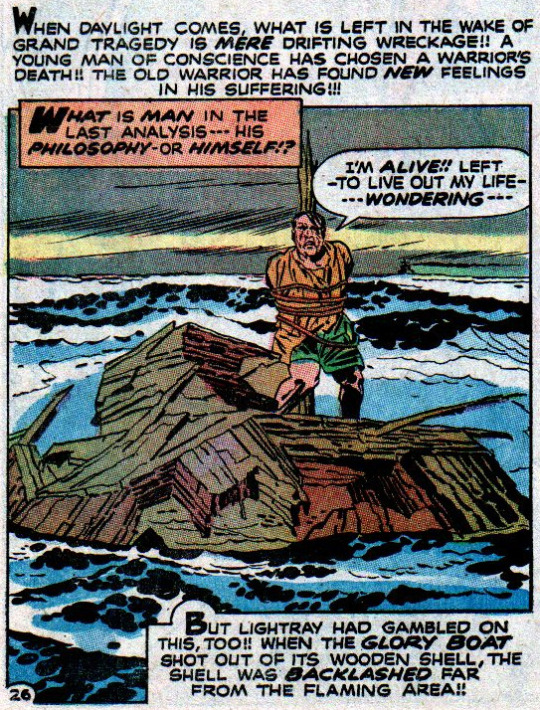
We can probably assume that Lightray and Orion later go back to retrieve Farley, or at least tell rescuers where he can be found — Orion is gruff, but he does have some concern for bystanders — but Kirby chooses to end on this tableau: Farley Sheridan coming to his senses, but still trapped in the wreckage of his shattered ideals.
This is heady stuff, and unlike many of DC's attempts at "relevance" in this period, it doesn't boil down to an obvious conclusion. Farley is a fool, to be sure (interesting, then, that he's the character closest to Kirby in age and experience), but the story isn't a straightforward endorsement of pacifism or even the need to change and compromise, which more conventional liberal morality plays (e.g., Star Trek) generally treat as the highest form of virtue. (Orion and Lightray kill all of their opponents in this story, and not even Lightray proposes that they talk it out!)
There's a line I often hear from comics fans and even comics pros who ought to know better to the effect that Kirby couldn't write (or, more offensively, couldn't write without Stan Lee to smooth things out). It's true that Kirby was never one for naturalistic dialogue, or the kind of quips and topical references that superhero comics often substitute for characterization, but "naturalistic" and "realistic" are not synonymous with "good." The Fourth World books in particular are largely unconcerned with realism (although they do contain a variety of topical references, some very pointed), but they're thematically rich and often vividly characterized, and Kirby's narrative drive and flair for the dramatic have few peers.
#comics#new gods#fourth world#jack kirby#vince colletta#mike royer#orion#lightray#the deep six#“You still have one final moment--to transcend your fate!”
12 notes
·
View notes
Text
HMS Surprise
Even though she is a great heroine in the novels of Patrick O'Brian, there was actually a frigate with this name. She was designed by Pierre-Alexandre Forfait as a corvette and launched on 16 January 1794 as Unité.
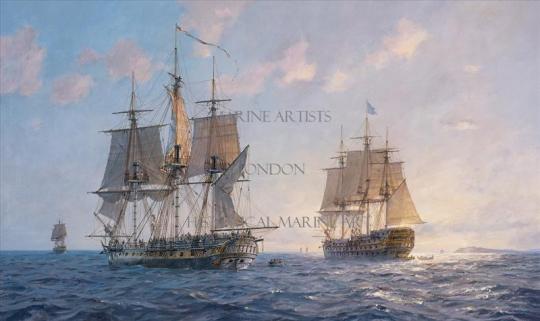
The Toulon Blockade - The newly-captured HMS Surprise (ex l’Unité) reporting to HMS Victory for orders. Sunset, 19th June 1796, by Geoff Hunt (x)
On 20 March 1794, the 41-year-old lieutenant de vaisseau Jean le Drézénec, who had joined the naval service shortly after the Revolution from the merchant service, took command of the Unité. He supervised the ship's equipment and found that the long guns were too large to be easily reloaded and the lower sails were also too large. He informed the authorities, who told him to stop equipping the ship as a major naval operation was imminent. Shortly afterwards, Unité took part in the Battle of the Glorious First of June, escorting the sunken Révolutionnaire, which was being towed by the Audacieux.
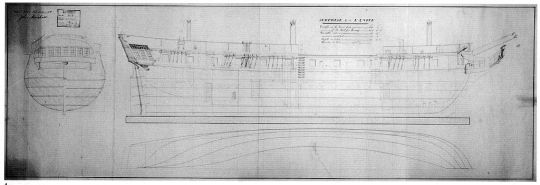
Plan of the Surprise/ Unité (x)
In June 1794, Unité finished repairs at Saint-Malo and Brest on the damage she had sustained in the battle. In the months that followed, she escorted merchant ships along the French coasts. On 28 September, together with the corvette Bergere and under the command of Lieutenant de Vaisseau Gouley, the two ships left Brest to sail north-west between Ireland and the islands of the Hebrides and St Kilda to intercept enemy merchant ships. On 17 October, the ships captured the merchant ship Dianne. The next day the weather deteriorated and the two ships were separated. Unwilling or unable to continue the mission alone, the Unité searched in vain for the Bergere for sixteen days before returning to Brest on 1 November. After repairs, the Unité was ordered to the Mediterranean fleet at Toulon, where she arrived in March 1795. She spent the rest of the year either blockading in port or as a courier ship. In April 1796 she was ordered to North Africa on one such courier service, bringing personnel and news to the port of Bône. Le Drézénec, who had been promoted to Capitaine de Frégate shortly before, was suffering from smallpox at the time and was not fit for service. Therefore, their first lieutenant, Le Breton, took command of the Unité.
Captain Thomas Fremantle, commanding the frigate HMS Inconstant, had heard that a French frigate was at Bône and sailed to intercept it. When the Unité arrived on the afternoon of 20 April 1796, the watch on board the Unité identified the Inconstant as a neutral ship and Le Breton did not release the ship for action. About an hour later, the Inconstant sailed alongside, boarded and captured Unité unharmed. She was renamed HMS Surprise and commissioned as a 28-gun frigate. In 1797 the ship was stationed in Jamaica and returned to the shipyard at Plymouth in January 1798. There the armament was changed to 24 32-pdr. carronades, 10 18-pdr. carronades and 2 long 4-pdr. guns; the hull was plated with copper.
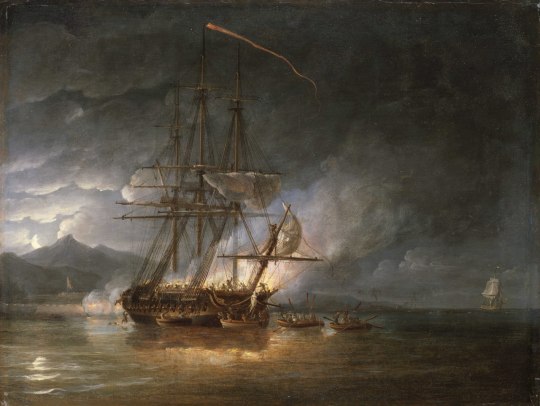
HMS Hermione being cut out of Puerto Cabello by boats from HMS Surprise (on the right), by Nicholas Pocock, late 18th century (x)
HMS Surprise gained fame for the recapture of HMS Hermione. The crew of the Hermione had mutinied and retreated with the ship to the Spanish port of Puerto Cabello. The captain of the Surprise led a privateer crew into the harbour on boats and, in a rather bloody raid, abducted the Hermione and the remaining crew under fire from the Spanish fort.
She had no more service time after that and so she was decommissioned in February 1802 and was broken up.
55 notes
·
View notes
Text

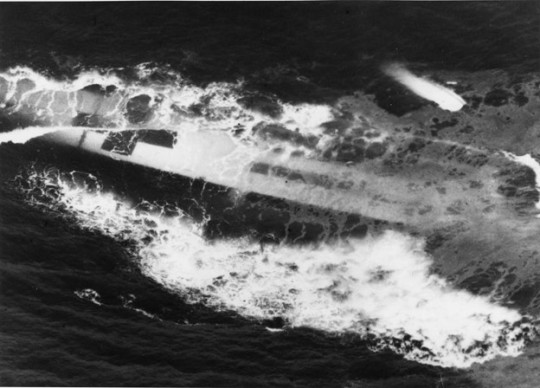
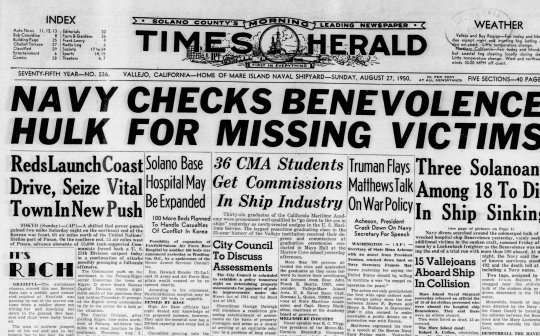
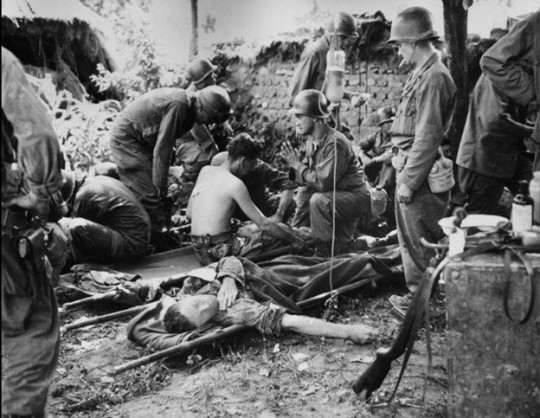
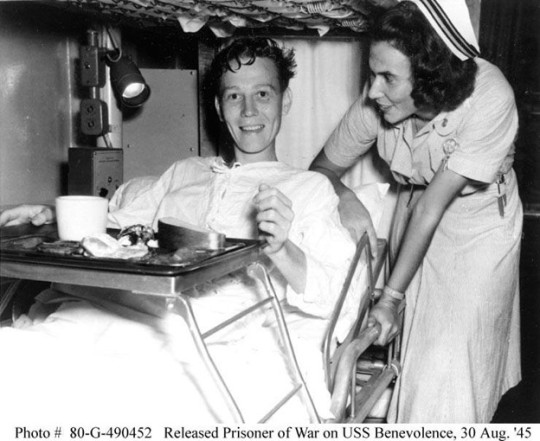

Life and Death at the Gate
At dawn on Sunday, 25 June 1950, the North Korean army crossed the 38th parallel supported by massed artillery fire. With the support of the Soviet Union the invasion was based on a false claim by North Korea that South Korean troops had attacked first. The real aim of the invasion was to take by force and subjugate South Korea under rule of the current North Korean leader's grandfather and his sham democracy. Condemned by the Free World, the invasion drew the first ever response by the United Nations, primarily supported by U.S. troops and aid. The war has technically never ended, and it resulted in millions killed and over 100,000 U.S. servicemen wounded or killed in action. In recognition of the coming carnage, a short time after the invasion, the World War II era hospital ship USS Benevolence (AH-13) was towed from a mothball fleet to Mare Island Naval Shipyard (MINS) in the San Francisco Bay Area to be taken out of mothballs and recommissioned. The US Navy Hospital Ship Benevolence would never make it to Korea. She tragically sank just minutes outside the Golden Gate while returning from sea trials.
Benevolence departed Mare Island at 0800 on 25 August 1950 for limited sea trials following recommissioning. Eight and a half hours later the fully loaded freighter SS Mary Luckenbac passed under the Golden Gate Bridge in thick fog bound for Philadelphia, Pennsylvania. Visibility was reported to vary from 300 to 400 yards. Radar had become common place by the 1950’s, but the Mary Luckenbac‘s radar had malfunctioned and was turned off. As the Mary Luckenbac passed under the bridge, she was on a collision course with the Benevolence returning from her sea trials. Aboard the Benevolence the radar was on and operating, but for some reason the crew was unaware of the approaching freighter. Both ships had bow lookouts posted and were operating their fog horns, but their combined closing speeds of 27 knots would doom the Benevolence. At an estimated 1,000 yards bow lookouts on the Benevolence sighted the bow wave of the approaching freighter. Benevolence began blasting the emergency signal on the ship’s horn as both ships attempted evasive action. It was too late, within three minutes the freighter slammed into the hospital ship raking her compartments open along the port side.
Following the collision both ships vanished into the fog. Unaware of the extent of the damage to his ship, Captain Barton E· Bacon on board the Benevolence gave no orders to prepare to abandon ship. However, within 5 minutes his ship’s main deck had sunk to sea level at the bow and she was listing 45 degrees, too far over to launch the lifeboats. The Benevolence had managed to transmit a message requesting emergency assistance just after the collision and then radio contact was lost. Twenty minutes later the Benevolence rolled over and sank in the shipping channel between Pt. Bonita and Seal Rocks. Five Hundred and twenty-five men and women went into the frigid water as the outgoing tide scattered them further out to sea. As word of the disaster spread a small armada of fishing boats, yachts, coast guard and naval vessels began scouring the seas in the thick fog looking for survivors. Survivors would continue to be found and pulled from the sea for nearly two days and as they were landed by rescue ships the Red Cross handed them a carton of cigarettes and the Service’s gave them booze. In the end eleven Navy, ten Military Sea Transportation Service and two MINS tradesmen were lost.
The Benevolence laid just beneath the waves in the south shipping channel as a hazard to navigation for sixteen months as separate courts of inquiry were held by the Navy and Coast Guard on Treasure Island and in San Francisco respectively. While the inquiries were underway MINS was directed to study the possibility of salvage. A no cure no pay request for proposals was sent to Bay Area salvage firms to evaluate the feasibility of salvage. A tanker suffered a minor collision with the Benevolence hulk, before MINS officials determined that salvage was not feasible, and the decision was made to remove the hazard with explosives. When you visit the USS San Francisco memorial near Lands’ End on the 49 Mile Scenic Drive and look out to sea you are overlooking the site of the Benevolence sinking.
#mare island#naval history#san francisco bay#us navy#vallejo#Korean War#Mary Luckenbac#Benevolence#Hospital Ship#Golden Gate#sink#collision#fog#survivor#drown
2 notes
·
View notes
Photo






On 22nd November 1869 the clipper “Cutty Sark” was launched at Dumbarton on the River Clyde.
Built on the River Leven that flows out of Loch Lomond and joins the Clyde at Dumbarton at a cost of £16,150. Many people will tell you it was a Clyde built ship, but that’s not entirely true
The Cutty Sark was commissioned by John Willis, a Scots born businessman, in the late 1860s. Scott and Linton were contracted to build the Cutty Sark for a price of £17 per ton, a very low price even in those days.
1869 Scott and Linton were bankrupted due to the low contract price but not before they had completed and launched the hull and named it Cutty Sark.
The hull was towed across the river Leven to William Denny and Brothers on the Clyde for fitting out; she was rigged ready to sail in only 12 weeks. Cutty Sark set sail from London on her maiden voyage to Shanghai on the 16th February 1870 under the command of Captain George Moodie.
It had a dedicated service to the tea and wool trades, until being sold to a Portuguese cargo company in 1895, whereupon it was renamed the Ferreira.
These extremely fast clippers were able to cover long distances without the need of getting to port to reload coal. However, the opening of the Suez Canal in 1869 shortened trade routes and made them lose their advantage over steam ships.
The ship’s name comes from Nannie, the witch in the Robert Burns poem Tam O’Shanter, who was dressed in only a “cutty sark” – an old Scottish term for a short nightie. The ship's figurehead, the original of which has been attributed to carver Fredrick Hellyer of Blackwall, is a stark white carving of a bare-breasted Nannie Dee with long hair holding a grey horse's tail in her han
In 1922, retired captain Wilfred Dowman bought the clipper for his personal use before, in 1938, his widow donated it to the training academy at Greenhithe, Kent to be used as a school ship by young cadets. At Greenhithe Cutty Sark acted as an auxiliary vessel to HMS Worcester for sail training drill, but by 1950 she had become surplus to requirements.
In 1953 Cutty Sark was given to the Cutty Sark Preservation Society and in 1954 she was moved to a custom-built dry dock at Greenwich. Cutty Sark was preserved as a museum ship, and has since become a popular tourist attraction.
In 2007 a devastating fire broke out aboard the Cutty Sark, and it appeared that the ship might be completely destroyed. Thankfully total disaster was avoided, but the subsequent restoration lasted until 2012. On 19th October 2014 she was damaged in a smaller fire.
Cutty Sark whisky derives its name from the ship. An image of the clipper appears on the label, and the maker formerly sponsored the Cutty Sark Tall Ships Race. The ship also inspired the name of the Saunders Roe Cutty Sark flying boat.
39 notes
·
View notes
Text


Today in Great Lakes shipping history. March 4.
Keewatin at Sault Ste. Marie near the end of her sailing career.
Keewatin as she looks today at Port McNicoll, ON
Marine Museum acquires vintage SS Keewatin passenger ship.
Kingston, ON – A 116-year-old steamship that ferried passengers and goods in the upper Great Lakes is bound for the Marine Museum of the Great Lakes at Kingston. The museum announced Friday that it had acquired the SS Keewatin from a development group in Port McNicoll, east of Midland, where it has been a museum ship since 2012.
“We’re pleased to steward the Keewatin through the next phase of its life here in Kingston,” Chris West, chair of the museum’s board, said. “The story of the Keewatin is a story of Canada’s creation as a country. It is vital that the ship, which is the last of its kind, be preserved for current and future generations, and our museum has the expertise, facilities and funding to be able to do this.”
Built in Scotland in 1907 and arriving in Canada the following year, the 336-foot Keewatin had to be cut into two pieces to fit through the Welland Canal. After being reassembled in Buffalo, it entered service and for 53 years sailed between Port McNicoll and Thunder Bay, linking the eastern and western railheads and carrying passengers and goods to ports for the Canadian Pacific Railway’s Great Lakes steamship service.
It was retired from service in 1965 and was sold to an American, who kept the ship docked in Douglas, Mich., as a museum for more than 45 years. Skyline International Development bought the 108-year-old freight and passenger liner in 2011 and towed it to Port McNicoll. It was to be the flagship, literally, for a large development that didn’t come to fruition.
Acquiring the Keewatin was a goal of the marine museum once it returned to its Queen Street location.
“We’re pleased to donate this historic and treasured passenger ship to the Marine Museum of the Great Lakes to ensure its continued long-term preservation,” Blake Lyon of Skyline Investments, the development company that owns the ship, said. “Kingston is an amazing location for the Keewatin to receive maximum exposure, and the marine museum, with its historic dry dock, is well qualified to maintain the Kee and showcase its important history — a goal we all share.”
Hundreds of volunteers in Port McNicoll spent thousands of hours restoring the ship, the last remaining Great Lakes passenger liner and the last of the Edwardian-era passenger liner steamships. The ship was valued at about $48 million by the Friends of the Keewatin, a group that lobbied to keep the ship in its home port.
The Keewatin is expected to arrive at the museum by early fall and is to be docked in the adjacent dry dock. The ship’s transfer to Kingston required approval from Heritage Canada.
Boat Nerd
19 notes
·
View notes
Text







"There is one group that hasn’t received recognition yet. And that is the tugs. Without them doing the heavy hauling and their ballet of movements around the ship pushing and pulling, Texas would have never left San Jacinto and dry docked safely at Gulf Copper. Our lead and stern tugs were the Wesley A and Cecil M. We were escorted by the tugs Zyana K, Dolphin, Audrey, and Hunter M. The escort tugs were there in case there was a situation that required them.
And we can’t forget the push boats that helped guide Texas out of her berth and again into the drydock. Those boats are the Captain Jim, Henry T, Jessica Lynn, Patrick J Studdert, Diamond Back, Bill Spence, and Margret K.
A big BZ and thank you to those boats, their captains and crew, and their companies. Bay Houston Towing Co, G&H Towing Company, T&T Salvage, Hard's Marine Service, Peninsula Marine Inc., and Texas Gulf."
Posted by Travis Davis to the Battleship Texas Foundation Group: link
#Battleship Texas#Battleship#Dreadnought#USS Texas (BB-35)#USS Texas#New York Class#Warship#Ship#Boat#August#2022#tugboat#boat#ship#warship#my post
28 notes
·
View notes
Photo

We took out the new trailer this weekend. I found the extra room it provided made for a much more relaxing weekend. Even the dogs were easier to deal with, because we weren’t stepping on them. Gas mileage in my F-150 tow vehicle dropped one full MPG with the heavier trailer.
Sheila recognized a name on a truck a few trailers away from us. It was the woman who bred our two older dogs. Ella and Oliver came from her farm. Oliver even lived with her for a year before coming to our home. It was fun seeing the breeder again, and she enjoyed seeing our dogs.

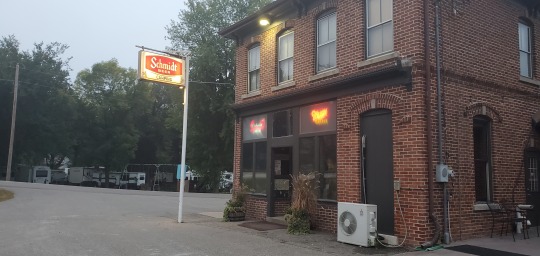
A feature I love in the new trailer is a booth and table large enough for six adults. It rained our first night there so Sheila, me, and our two friends ate dinner inside our trailer. We could not do that previously. That area converts to a bed, perfectly sized for three Miniature Australian Shepherds.
The campground has a bar and grill. That building was constructed in 1867. I love that sort of history. Five families have owned it over the years. We ate dinner there both nights. Dogs were allowed on the patio.
Today, after getting home, we went to a memorial service for one of Sheila’s cousins. Though a sad occasion, it was nice seeing all the extended family. The service was held at a really cool pavilion in Minneapolis, right on the Mississippi River. I wouldn’t have missed it for anything, but the open bar was a nice touch. I want that for my funeral.
Afterwards we went with my SIL, BIL and their kids to the brewery by our house to watch the Vikings/Lions game. My BIL and nephew know a lot more about football than I do, so it’s fun hearing their take on the game.
Teenagers:

Backtrack: The camp site was near Red Wing, MN. It’s a nice small town. There’s a paddle boat docked there. It does cruises up and down the Mississippi. The old train station is still in use for Amtrak. I like it.


48 notes
·
View notes
Text
What Parts of a Yacht Need Regular Maintenance?

Yacht repair is just as crucial to Dubai, United Arab Emirates, and megayacht owners as operating the boat. Superyachts need substantial financial outlays, and numerous components of this asset need routine maintenance to ensure reliable functioning. The major objective of the superyacht refit in Dubai is to maintain the yacht's regular functioning for many years.
Yacht maintenance is crucial for travelers' safety and their own peace of mind. With increasing yacht size comes an increase in system complexity. In this blog post, we make an effort to outline the various yacht components that need routine maintenance. The value of your cruise yacht will also be preserved with regular maintenance of these components.
READ MORE:
#yacht maintenance#boat maintenance#super yacht#yacht services#mega yacht#boat services#boat maintenace#yacht repair#in Dubai#yacht refit#yacht management#boat refit#Yacht price/ cost#yacht towing#boat towing#Dubai UAE
0 notes
Text
20k Leagues under the Sea, Jules Verne
<< PREVIOUS
Chapter 7-8
CHAPTER VII
AN UNKNOWN SPECIES OF WHALE
This unexpected fall so stunned me that I have no clear recollection of my sensations at the time. I was at first drawn down to a depth of about twenty feet. I am a good swimmer (though without pretending to rival Byron or Edgar Poe, who were masters of the art), and in that plunge I did not lose my presence of mind. Two vigorous strokes brought me to the surface of the water. My first care was to look for the frigate. Had the crew seen me disappear? Had the Abraham Lincoln veered round? Would the captain put out a boat? Might I hope to be saved?
The darkness was intense. I caught a glimpse of a black mass disappearing in the east, its beacon lights dying out in the distance. It was the frigate! I was lost.
“Help, help!” I shouted, swimming towards the Abraham Lincoln in desperation.
My clothes encumbered me; they seemed glued to my body, and paralysed my movements.
I was sinking! I was suffocating!
“Help!”
This was my last cry. My mouth filled with water; I struggled against being drawn down the abyss. Suddenly my clothes were seized by a strong hand, and I felt myself quickly drawn up to the surface of the sea; and I heard, yes, I heard these words pronounced in my ear—
“If master would be so good as to lean on my shoulder, master would swim with much greater ease.”
I seized with one hand my faithful Conseil’s arm.
“Is it you?” said I, “you?”
“Myself,” answered Conseil; “and waiting master’s orders.”
“That shock threw you as well as me into the sea?”
“No; but being in my master’s service, I followed him.”
The worthy fellow thought that was but natural.
“And the frigate?” I asked.
“The frigate?” replied Conseil, turning on his back; “I think that master had better not count too much on her.”
“You think so?”
“I say that, at the time I threw myself into the sea, I heard the men at the wheel say, ‘The screw and the rudder are broken.’”
“Broken?”
“Yes, broken by the monster’s teeth. It is the only injury the Abraham Lincoln has sustained. But it is a bad look out for us—she no longer answers her helm.”
“Then we are lost!”
“Perhaps so,” calmly answered Conseil. “However, we have still several hours before us, and one can do a good deal in some hours.”
Conseil’s imperturbable coolness set me up again. I swam more vigorously; but, cramped by my clothes, which stuck to me like a leaden weight, I felt great difficulty in bearing up. Conseil saw this.
“Will master let me make a slit?” said he; and, slipping an open knife under my clothes, he ripped them up from top to bottom very rapidly. Then he cleverly slipped them off me, while I swam for both of us.
Then I did the same for Conseil, and we continued to swim near to each other.
Nevertheless, our situation was no less terrible. Perhaps our disappearance had not been noticed; and if it had been, the frigate could not tack, being without its helm. Conseil argued on this supposition, and laid his plans accordingly. This phlegmatic boy was perfectly self-possessed. We then decided that, as our only chance of safety was being picked up by the Abraham Lincoln’s boats, we ought to manage so as to wait for them as long as possible. I resolved then to husband our strength, so that both should not be exhausted at the same time; and this is how we managed: while one of us lay on our back, quite still, with arms crossed, and legs stretched out, the other would swim and push the other on in front. This towing business did not last more than ten minutes each; and relieving each other thus, we could swim on for some hours, perhaps till daybreak. Poor chance! but hope is so firmly rooted in the heart of man! Moreover, there were two of us. Indeed I declare (though it may seem improbable) if I sought to destroy all hope,—if I wished to despair, I could not.
The collision of the frigate with the cetacean had occurred about eleven o’clock the evening before. I reckoned then we should have eight hours to swim before sunrise, an operation quite practicable if we relieved each other. The sea, very calm, was in our favour. Sometimes I tried to pierce the intense darkness that was only dispelled by the phosphorescence caused by our movements. I watched the luminous waves that broke over my hand, whose mirror-like surface was spotted with silvery rings. One might have said that we were in a bath of quicksilver.
Near one o’clock in the morning, I was seized with dreadful fatigue. My limbs stiffened under the strain of violent cramp. Conseil was obliged to keep me up, and our preservation devolved on him alone. I heard the poor boy pant; his breathing became short and hurried. I found that he could not keep up much longer.
“Leave me! leave me!” I said to him.
“Leave my master? Never!” replied he. “I would drown first.”
Just then the moon appeared through the fringes of a thick cloud that the wind was driving to the east. The surface of the sea glittered with its rays. This kindly light reanimated us. My head got better again. I looked at all points of the horizon. I saw the frigate! She was five miles from us, and looked like a dark mass, hardly discernible. But no boats!
I would have cried out. But what good would it have been at such a distance! My swollen lips could utter no sounds. Conseil could articulate some words, and I heard him repeat at intervals, “Help! help!”
Our movements were suspended for an instant; we listened. It might be only a singing in the ear, but it seemed to me as if a cry answered the cry from Conseil.
“Did you hear?” I murmured.
“Yes! Yes!”
And Conseil gave one more despairing call.
This time there was no mistake! A human voice responded to ours! Was it the voice of another unfortunate creature, abandoned in the middle of the ocean, some other victim of the shock sustained by the vessel? Or rather was it a boat from the frigate, that was hailing us in the darkness?
Conseil made a last effort, and, leaning on my shoulder, while I struck out in a despairing effort, he raised himself half out of the water, then fell back exhausted.
“What did you see?”
“I saw”—murmured he; “I saw—but do not talk—reserve all your strength!”
What had he seen? Then, I know not why, the thought of the monster came into my head for the first time! But that voice! The time is past for Jonahs to take refuge in whales’ bellies! However, Conseil was towing me again. He raised his head sometimes, looked before us, and uttered a cry of recognition, which was responded to by a voice that came nearer and nearer. I scarcely heard it. My strength was exhausted; my fingers stiffened; my hand afforded me support no longer; my mouth, convulsively opening, filled with salt water. Cold crept over me. I raised my head for the last time, then I sank.
At this moment a hard body struck me. I clung to it: then I felt that I was being drawn up, that I was brought to the surface of the water, that my chest collapsed:—I fainted.
It is certain that I soon came to, thanks to the vigorous rubbings that I received. I half opened my eyes.
“Conseil!” I murmured.
“Does master call me?” asked Conseil.
Just then, by the waning light of the moon which was sinking down to the horizon, I saw a face which was not Conseil’s and which I immediately recognised.
“Ned!” I cried.
“The same, sir, who is seeking his prize!” replied the Canadian.
“Were you thrown into the sea by the shock to the frigate?”
“Yes, Professor; but more fortunate than you, I was able to find a footing almost directly upon a floating island.”
“An island?”
“Or, more correctly speaking, on our gigantic narwhal.”
“Explain yourself, Ned!”
“Only I soon found out why my harpoon had not entered its skin and was blunted.”
“Why, Ned, why?”
“Because, Professor, that beast is made of sheet iron.”
The Canadian’s last words produced a sudden revolution in my brain. I wriggled myself quickly to the top of the being, or object, half out of the water, which served us for a refuge. I kicked it. It was evidently a hard impenetrable body, and not the soft substance that forms the bodies of the great marine mammalia. But this hard body might be a bony carapace, like that of the antediluvian animals; and I should be free to class this monster among amphibious reptiles, such as tortoises or alligators.
Well, no! the blackish back that supported me was smooth, polished, without scales. The blow produced a metallic sound; and incredible though it may be, it seemed, I might say, as if it was made of riveted plates.
There was no doubt about it! This monster, this natural phenomenon that had puzzled the learned world, and overthrown and misled the imagination of seamen of both hemispheres, it must be owned, a still more astonishing phenomenon, inasmuch as it was a simply human construction.
We had no time to lose, however. We were lying upon the back of a sort of submarine boat, which appeared (as far as I could judge) like a huge fish of steel. Ned Land’s mind was made up on this point. Conseil and I could only agree with him.
Just then a bubbling began at the back of this strange thing (which was evidently propelled by a screw), and it began to move. We had only just time to seize hold of the upper part, which rose about seven feet out of the water, and happily its speed was not great.
“As long as it sails horizontally,” muttered Ned Land, “I do not mind; but if it takes a fancy to dive, I would not give two straws for my life.”
The Canadian might have said still less. It became really necessary to communicate with the beings, whatever they were, shut up inside the machine. I searched all over the outside for an aperture, a panel, or a man-hole, to use a technical expression; but the lines of the iron rivets, solidly driven into the joints of the iron plates, were clear and uniform. Besides, the moon disappeared then, and left us in total darkness.
At last this long night passed. My indistinct remembrance prevents my describing all the impressions it made. I can only recall one circumstance. During some lulls of the wind and sea, I fancied I heard several times vague sounds, a sort of fugitive harmony produced by words of command. What was then the mystery of this submarine craft, of which the whole world vainly sought an explanation? What kind of beings existed in this strange boat? What mechanical agent caused its prodigious speed?
Daybreak appeared. The morning mists surrounded us, but they soon cleared off. I was about to examine the hull, which formed on deck a kind of horizontal platform, when I felt it gradually sinking.
“Oh! confound it!” cried Ned Land, kicking the resounding plate. “Open, you inhospitable rascals!”
Happily the sinking movement ceased. Suddenly a noise, like iron works violently pushed aside, came from the interior of the boat. One iron plate was moved, a man appeared, uttered an odd cry, and disappeared immediately.
Some moments after, eight strong men, with masked faces, appeared noiselessly, and drew us down into their formidable machine.
CHAPTER VIII
MOBILIS IN MOBILI
This forcible abduction, so roughly carried out, was accomplished with the rapidity of lightning. I shivered all over. Whom had we to deal with? No doubt some new sort of pirates, who explored the sea in their own way.
Hardly had the narrow panel closed upon me, when I was enveloped in darkness. My eyes, dazzled with the outer light, could distinguish nothing. I felt my naked feet cling to the rungs of an iron ladder. Ned Land and Conseil, firmly seized, followed me. At the bottom of the ladder, a door opened, and shut after us immediately with a bang.
We were alone. Where, I could not say, hardly imagine. All was black, and such a dense black that, after some minutes, my eyes had not been able to discern even the faintest glimmer.
Meanwhile, Ned Land, furious at these proceedings, gave free vent to his indignation.
“Confound it!” cried he, “here are people who come up to the Scotch for hospitality. They only just miss being cannibals. I should not be surprised at it, but I declare that they shall not eat me without my protesting.”
“Calm yourself, friend Ned, calm yourself,” replied Conseil, quietly. “Do not cry out before you are hurt. We are not quite done for yet.”
“Not quite,” sharply replied the Canadian, “but pretty near, at all events. Things look black. Happily, my bowie knife I have still, and I can always see well enough to use it. The first of these pirates who lays a hand on me——”
“Do not excite yourself, Ned,” I said to the harpooner, “and do not compromise us by useless violence. Who knows that they will not listen to us? Let us rather try to find out where we are.”
I groped about. In five steps I came to an iron wall, made of plates bolted together. Then turning back I struck against a wooden table, near which were ranged several stools. The boards of this prison were concealed under a thick mat of phormium, which deadened the noise of the feet. The bare walls revealed no trace of window or door. Conseil, going round the reverse way, met me, and we went back to the middle of the cabin, which measured about twenty feet by ten. As to its height, Ned Land, in spite of his own great height, could not measure it.
Half an hour had already passed without our situation being bettered, when the dense darkness suddenly gave way to extreme light. Our prison was suddenly lighted—that is to say, it became filled with a luminous matter, so strong that I could not bear it at first. In its whiteness and intensity I recognised that electric light which played round the submarine boat like a magnificent phenomenon of phosphorescence. After shutting my eyes involuntarily, I opened them, and saw that this luminous agent came from a half globe, unpolished, placed in the roof of the cabin.
“At last one can see,” cried Ned Land, who, knife in hand, stood on the defensive.
“Yes,” said I; “but we are still in the dark about ourselves.”
“Let master have patience,” said the imperturbable Conseil.
The sudden lighting of the cabin enabled me to examine it minutely. It only contained a table and five stools. The invisible door might be hermetically sealed. No noise was heard. All seemed dead in the interior of this boat. Did it move, did it float on the surface of the ocean, or did it dive into its depths? I could not guess.
A noise of bolts was now heard, the door opened, and two men appeared.
One was short, very muscular, broad-shouldered, with robust limbs, strong head, an abundance of black hair, thick moustache, a quick penetrating look, and the vivacity which characterises the population of Southern France.
The second stranger merits a more detailed description. A disciple of Gratiolet or Engel would have read his face like an open book. I made out his prevailing qualities directly:—self-confidence,—because his head was well set on his shoulders, and his black eyes looked around with cold assurance; calmness,—for his skin, rather pale, showed his coolness of blood; energy,—evinced by the rapid contraction of his lofty brows; and courage,—because his deep breathing denoted great power of lungs.
Whether this person was thirty-five or fifty years of age, I could not say. He was tall, had a large forehead, straight nose, a clearly cut mouth, beautiful teeth, with fine taper hands, indicative of a highly nervous temperament. This man was certainly the most admirable specimen I had ever met. One particular feature was his eyes, rather far from each other, and which could take in nearly a quarter of the horizon at once.
This faculty—(I verified it later)—gave him a range of vision far superior to Ned Land’s. When this stranger fixed upon an object, his eyebrows met, his large eyelids closed around so as to contract the range of his vision, and he looked as if he magnified the objects lessened by distance, as if he pierced those sheets of water so opaque to our eyes, and as if he read the very depths of the seas.
The two strangers, with caps made from the fur of the sea otter, and shod with sea boots of seal’s skin, were dressed in clothes of a particular texture, which allowed free movement of the limbs. The taller of the two, evidently the chief on board, examined us with great attention, without saying a word; then turning to his companion, talked with him in an unknown tongue. It was a sonorous, harmonious, and flexible dialect, the vowels seeming to admit of very varied accentuation.
The other replied by a shake of the head, and added two or three perfectly incomprehensible words. Then he seemed to question me by a look.
I replied in good French that I did not know his language; but he seemed not to understand me, and my situation became more embarrassing.
“If master were to tell our story,” said Conseil, “perhaps these gentlemen may understand some words.”
I began to tell our adventures, articulating each syllable clearly, and without omitting one single detail. I announced our names and rank, introducing in person Professor Aronnax, his servant Conseil, and master Ned Land, the harpooner.
The man with the soft calm eyes listened to me quietly, even politely, and with extreme attention; but nothing in his countenance indicated that he had understood my story. When I finished, he said not a word. There remained one resource, to speak English. Perhaps they would know this almost universal language. I knew it, as well as the German language,—well enough to read it fluently, but not to speak it correctly. But, anyhow, we must make ourselves understood.
“Go on in your turn,” I said to the harpooner; “speak your best Anglo-Saxon, and try to do better than I.”
Ned did not beg off, and recommenced our story.
To his great disgust, the harpooner did not seem to have made himself more intelligible than I had. Our visitors did not stir. They evidently understood neither the language of Arago nor of Faraday.
Very much embarrassed, after having vainly exhausted our speaking resources, I knew not what part to take, when Conseil said—
“If master will permit me, I will relate it in German.”
But in spite of the elegant terms and good accent of the narrator, the German language had no success. At last, nonplussed, I tried to remember my first lessons, and to narrate our adventures in Latin, but with no better success. This last attempt being of no avail, the two strangers exchanged some words in their unknown language, and retired.
The door shut.
“It is an infamous shame,” cried Ned Land, who broke out for the twentieth time. “We speak to those rogues in French, English, German, and Latin, and not one of them has the politeness to answer!”
“Calm yourself,” I said to the impetuous Ned, “anger will do no good.”
“But do you see, Professor,” replied our irascible companion, “that we shall absolutely die of hunger in this iron cage?”
“Bah!” said Conseil, philosophically; “we can hold out some time yet.”
“My friends,” I said, “we must not despair. We have been worse off than this. Do me the favour to wait a little before forming an opinion upon the commander and crew of this boat.”
“My opinion is formed,” replied Ned Land, sharply. “They are rascals.”
“Good! and from what country?”
“From the land of rogues!”
“My brave Ned, that country is not clearly indicated on the map of the world; but I admit that the nationality of the two strangers is hard to determine. Neither English, French, nor German, that is quite certain. However, I am inclined to think that the commander and his companion were born in low latitudes. There is southern blood in them. But I cannot decide by their appearance whether they are Spaniards, Turks, Arabians, or Indians. As to their language, it is quite incomprehensible.”
“There is the disadvantage of not knowing all languages,” said Conseil, “or the disadvantage of not having one universal language.”
As he said these words, the door opened. A steward entered. He brought us clothes, coats and trousers, made of a stuff I did not know. I hastened to dress myself, and my companions followed my example. During that time, the steward—dumb, perhaps deaf—had arranged the table, and laid three plates.
“This is something like,” said Conseil.
“Bah!” said the rancorous harpooner, “what do you suppose they eat here? Tortoise liver, filleted shark, and beefsteaks from sea-dogs.”
“We shall see,” said Conseil.
The dishes, of bell metal, were placed on the table, and we took our places. Undoubtedly we had to do with civilised people, and, had it not been for the electric light which flooded us, I could have fancied I was in the dining-room of the Adelphi Hotel at Liverpool, or at the Grand Hotel in Paris. I must say, however, that there was neither bread nor wine. The water was fresh and clear, but it was water, and did not suit Ned Land’s taste. Amongst the dishes which were brought to us, I recognised several fish delicately dressed; but of some, although excellent, I could give no opinion, neither could I tell to what kingdom they belonged, whether animal or vegetable. As to the dinner service, it was elegant, and in perfect taste. Each utensil, spoon, fork, knife, plate, had a letter engraved on it, with a motto above it, of which this is an exact facsimile:—
MOBILIS IN MOBILI
N.
The letter N was no doubt the initial of the name of the enigmatical person, who commanded at the bottom of the sea.
Ned and Conseil did not reflect much. They devoured the food, and I did likewise. I was, besides, reassured as to our fate; and it seemed evident that our hosts would not let us die of want.
However, everything has an end, everything passes away, even the hunger of people who have not eaten for fifteen hours. Our appetites satisfied, we felt overcome with sleep.
“Faith! I shall sleep well,” said Conseil.
“So shall I,” replied Ned Land.
My two companions stretched themselves on the cabin carpet, and were soon sound asleep. For my own part, too many thoughts crowded my brain, too many insoluble questions pressed upon me, too many fancies kept my eyes half open. Where were we? What strange power carried us on? I felt—or rather fancied I felt—the machine sinking down to the lowest beds of the sea. Dreadful nightmares beset me; I saw in these mysterious asylums a world of unknown animals, amongst which this submarine boat seemed to be of the same kind, living, moving, and formidable as they. Then my brain grew calmer, my imagination wandered into vague unconsciousness, and I soon fell into a deep sleep.
NEXT >>
5 notes
·
View notes
Photo

In the 1940's Lucille visited her hometown of Jamestown, New York. Before her arrival, the Jamestown Chamber of Commerce had written to her to ask her what she'd like to do most on her upcoming trip. 'She had written back that she'd like a long ride on the big excursion steamer she remembered riding as a child, cruising around Lake Chautauqua. "Nobody told me that the "City of Jamestown" had been at the bottom of the lake for years," she said wryly, "and when they got my letter about wanting a ride on it, they dredged it up and completely refurbished it. I got my ride on it all right, together with six hundred people, after the town had spent a fortune bringing the boat up to date!"'—The Real Story of Lucille Ball by Eleanor Harris, 1954. Note: Lucille may have been mistaken when referring to this particular boat as being at the bottom of the lake. I could find no evidence of it ever sinking. Two other steamships met their demise on the lake in the mid 1930's—one sank, the other burned. I was able to locate an article stating that the City of Jamestown once ran aground in the 1950's, but never sank. It was towed from the sandbar and remained in service until June 6, 1963. #lucilleball #steamship #boat #lake #chautauqualake #jamestownny #chamberofcommerce #waynelvslcy #ilovelucy #sinkingship https://www.instagram.com/p/Cqa_IY0JqtK/?igshid=NGJjMDIxMWI=
#lucilleball#steamship#boat#lake#chautauqualake#jamestownny#chamberofcommerce#waynelvslcy#ilovelucy#sinkingship
2 notes
·
View notes